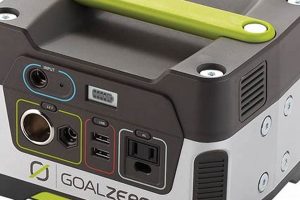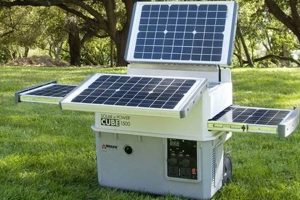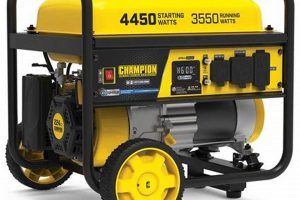High-quality, lightweight power sources designed for outdoor recreational use offer a convenient way to electrify campsites. These units typically employ gasoline, propane, or solar energy to generate electricity, enabling campers to power devices such as lights, refrigerators, and electronic gadgets. A suitable unit might power a small coffee maker and charge several phones simultaneously, illustrating the practical application of these devices.
Access to reliable electricity enhances the camping experience by increasing comfort and safety. Lighting campsites after dark improves visibility and security, while refrigeration keeps food fresh for longer periods. The ability to charge essential devices like phones or medical equipment adds another layer of safety. Historically, campers relied on less convenient methods, such as flashlights and ice chests. The evolution of portable power technology has significantly expanded the possibilities for comfortable and connected outdoor experiences.
Selecting a suitable power source requires careful consideration of factors including power output, fuel type, portability, noise levels, and runtime. This article will further explore these crucial selection criteria and highlight some leading models available to consumers.
Tips for Selecting a Portable Power Source for Camping
Choosing the right portable power solution for a camping trip requires careful consideration of various factors to ensure compatibility with power needs and the camping environment.
Tip 1: Calculate Power Requirements: Determine the total wattage required to run all intended devices. Adding the wattage of each item provides an estimate of the minimum power output needed from the generator.
Tip 2: Consider Fuel Type and Availability: Gasoline generators offer readily available fuel, while propane generators tend to be quieter. Solar generators are an environmentally friendly option but depend on sunlight availability.
Tip 3: Evaluate Runtime and Fuel Efficiency: Longer runtimes reduce the frequency of refueling. Fuel efficiency impacts operating costs and environmental impact.
Tip 4: Assess Portability: Consider the weight and dimensions of the generator, especially if hiking to the campsite. Built-in wheels and handles can enhance portability.
Tip 5: Prioritize Noise Levels: Lower decibel ratings contribute to a more peaceful camping experience for oneself and fellow campers.
Tip 6: Examine Safety Features: Features such as overload protection, low-oil shutdown, and carbon monoxide detectors are crucial for safe operation.
Tip 7: Research and Compare Models: Reading reviews and comparing specifications from reputable manufacturers aids in making an informed decision.
Tip 8: Consider Budget: Portable power generators vary significantly in price. Establish a budget beforehand to narrow down the options.
Careful consideration of these factors ensures selection of a power solution that meets individual needs and enhances the overall camping experience. A well-chosen portable power source allows campers to enjoy the comforts of electricity while minimizing environmental impact and respecting fellow outdoor enthusiasts.
By following these guidelines, consumers can confidently select a suitable portable power source to enhance their next camping adventure.
1. Power Output
Power output, measured in watts, represents a critical factor in selecting a portable generator for camping. Understanding power needs ensures devices receive adequate electricity for optimal performance. Insufficient power may lead to malfunction or damage, while excessive power represents unnecessary weight and fuel consumption.
- Running Watts vs. Starting Watts
Running watts indicate the continuous power supply, essential for consistently powering devices. Starting watts, higher than running watts, provide the surge of power needed to start motor-driven appliances like refrigerators. Matching generator output to device requirements is essential. For example, a refrigerator requiring 800 starting watts and 200 running watts necessitates a generator capable of handling both.
- Wattage Needs Assessment
Calculating total wattage requirements involves summing the wattage of all intended devices. This calculation ensures the generator can handle the combined load. Overloading a generator can lead to damage or failure. A camping setup involving a 60-watt laptop, a 150-watt electric grill, and a 50-watt fan requires a generator with at least 260 running watts.
- Power Output and Generator Size/Weight
Generally, higher power output correlates with larger and heavier generators. Balancing power needs with portability is crucial, especially for backpackers or those hiking to campsites. A higher-wattage generator might necessitate a wheeled carrier, impacting campsite selection and maneuverability.
- Power Output and Fuel Consumption
Higher power output typically corresponds to increased fuel consumption. Understanding this relationship aids in planning fuel needs and minimizing environmental impact. A more powerful generator might require more frequent refueling, increasing cost and logistical considerations.
Careful consideration of power output ensures compatibility with intended devices and aligns with overall camping goals. Balancing power needs with portability, fuel efficiency, and budget leads to a more satisfying and sustainable outdoor experience. Selecting a generator with appropriate power output ensures functionality without unnecessary bulk or fuel consumption, optimizing the balance between power and practicality for a successful camping trip.
2. Portability
Portability represents a crucial factor in selecting a power source for camping, directly influencing ease of transport and campsite setup. Weight, dimensions, and integrated carrying features significantly impact the overall camping experience, especially in remote locations or when hiking to a campsite. Balancing power needs with portability is essential for a successful and enjoyable trip.
- Weight and Dimensions
The physical size and weight of a generator dictate its portability. Lighter, more compact units are easier to transport, particularly over longer distances or uneven terrain. Bulky, heavy generators may require wheeled transport, limiting accessibility to certain campsites. For backpackers, weight is a primary concern, often necessitating smaller, lighter power solutions.
- Integrated Carrying Features
Features like telescoping handles, built-in wheels, and ergonomic grips enhance portability. These design elements facilitate easier maneuvering and reduce strain during transport. A generator with a well-designed handle and sturdy wheels can be significantly easier to move than a comparably sized unit lacking these features.
- Impact on Campsite Selection
Generator portability influences campsite choice. Larger, less portable units may restrict access to certain areas, particularly those requiring hiking or with limited vehicle access. Portability considerations may necessitate choosing a campsite closer to vehicle access, potentially impacting the overall wilderness experience.
- Setup and Maneuverability
Ease of setup and maneuverability within the campsite are important aspects of portability. A compact, lightweight generator is simpler to position and connect to devices. This ease of use contributes to a more efficient and enjoyable camping experience, especially in challenging terrain or limited space.
Careful consideration of portability factors ensures the chosen power source aligns with the specific needs and limitations of the camping trip. Prioritizing portability contributes to a smoother, more enjoyable experience, allowing campers to focus on enjoying the outdoors rather than struggling with cumbersome equipment. The right balance between power and portability enhances overall camping satisfaction.
3. Runtime
Runtime, the duration a portable power generator operates on a single fuel charge or battery cycle, represents a critical factor influencing camping convenience and planning. Adequate runtime ensures consistent power availability throughout the trip, minimizing interruptions and maximizing enjoyment. Evaluating runtime requires considering factors such as power output, fuel capacity, and efficiency.
- Fuel Capacity and Efficiency
Fuel tank capacity and the generator’s fuel efficiency directly impact runtime. Larger fuel tanks generally provide longer runtimes, while efficient fuel consumption reduces the frequency of refueling, crucial for extended camping trips or remote locations. A fuel-efficient generator with a large tank minimizes interruptions for refueling, enabling longer periods of uninterrupted power supply. Conversely, a smaller tank or less efficient engine may necessitate more frequent refueling, impacting convenience and potentially requiring carrying extra fuel.
- Power Output and Load
Power output and the load placed on the generator influence runtime. Higher power output combined with heavy loads typically reduces runtime. Matching generator capacity to actual power needs optimizes runtime and fuel efficiency. Running a high-wattage appliance like an electric heater on a small generator will significantly decrease its runtime compared to powering smaller devices like lights or fans.
- Battery Capacity (for Solar or Battery-Powered Generators)
For solar or battery-powered generators, battery capacity determines runtime. Larger battery capacity provides longer operation without recharging or sunlight. Understanding battery capacity and recharge times is essential for planning power usage and ensuring consistent availability. A high-capacity battery offers greater flexibility and longer periods of use, while a smaller battery may require more frequent recharging, potentially limiting device usage.
- Impact on Camping Activities and Convenience
Runtime directly influences camping activities and overall convenience. Sufficient runtime ensures continuous power for essential devices, enhancing comfort and safety. Inadequate runtime may restrict device usage or necessitate inconvenient refueling or recharging during the trip. A generator with sufficient runtime enables uninterrupted use of essential appliances, contributing to a more comfortable and enjoyable camping experience.
Careful consideration of runtime during generator selection ensures uninterrupted power for desired camping activities. Balancing runtime with factors like portability, power output, and fuel type ensures the chosen generator meets the specific demands of the camping trip, enhancing overall enjoyment and convenience. Selecting a generator with appropriate runtime contributes to a seamless and more satisfying outdoor experience.
4. Noise Level
Noise level, measured in decibels (dB), represents a critical consideration when selecting a portable power generator for camping. Excessive noise can disrupt the tranquility of the natural environment, impacting the camping experience for both the user and surrounding campers. Minimizing noise pollution demonstrates respect for the natural environment and fosters positive relationships within the camping community. A quiet generator contributes significantly to a more peaceful and enjoyable outdoor experience for everyone.
Generators produce noise due to engine operation and cooling fans. Noise levels vary significantly between models and depend on factors such as power output and engine design. Manufacturers often specify noise levels at a given distance, typically measured in dB(A), a weighted scale that approximates human hearing. Comparing dB(A) ratings aids in selecting a quieter model. For instance, a generator rated at 50 dB(A) at 23 feet will be significantly quieter than one rated at 70 dB(A) at the same distance. Opting for quieter generators helps preserve the natural soundscape and minimizes disturbance to wildlife.
Choosing a quiet generator enhances the overall camping experience. Lower noise levels contribute to relaxation and enjoyment of the natural environment. Respecting noise level etiquette also fosters positive relationships with fellow campers. Some campsites enforce noise restrictions, further emphasizing the importance of selecting a quiet generator. Ultimately, prioritizing noise reduction contributes to a more harmonious and respectful camping experience for all. This consideration aligns with principles of Leave No Trace ethics, promoting responsible enjoyment of the outdoors.
5. Fuel Type
Fuel type significantly influences the practicality and environmental impact of portable power generators for camping. Careful consideration of fuel availability, cost, and environmental impact is essential for selecting a generator that aligns with camping needs and responsible outdoor practices. Different fuel types offer distinct advantages and disadvantages, impacting generator performance, maintenance requirements, and overall camping experience.
- Gasoline
Gasoline generators offer wide availability and generally higher power output. However, they produce exhaust fumes and require regular maintenance, including oil changes. Gasoline storage requires caution due to flammability. The prevalence of gasoline makes refueling relatively easy in most areas, although transporting gasoline requires appropriate containers and safety precautions. Gasoline generators are often a practical choice for powering higher-wattage appliances but may be less suitable for environmentally sensitive areas or where quiet operation is paramount.
- Propane
Propane generators typically operate more quietly than gasoline models and produce cleaner emissions. Propane can be stored for extended periods without degradation, simplifying long-term storage. Propane availability can be more limited than gasoline, particularly in remote areas. Propane generators often represent a good balance between power, noise level, and environmental impact, making them suitable for a wide range of camping scenarios.
- Solar
Solar generators utilize photovoltaic panels to convert sunlight into electricity, offering a clean and silent power solution. Performance depends on sunlight availability, making them less reliable in cloudy conditions or shaded areas. Solar generators often require longer charging times compared to refueling gasoline or propane models. They represent an environmentally conscious choice for powering smaller devices and are ideal for campers prioritizing sustainability and minimal environmental impact.
- Dual Fuel
Dual-fuel generators offer flexibility by operating on either gasoline or propane. This adaptability provides a backup power solution in case one fuel type becomes unavailable. Switching between fuel sources typically involves a simple process. Dual-fuel generators combine the advantages of both fuel types, offering convenience and redundancy for campers seeking reliable power in diverse situations. This versatility makes them a practical option for extended trips or remote locations where fuel availability may be uncertain.
Selecting the appropriate fuel type depends on individual camping needs and priorities. Balancing factors like power requirements, runtime expectations, environmental considerations, and fuel availability ensures the chosen generator enhances the camping experience while minimizing negative impacts. A careful assessment of fuel type contributes significantly to a successful and responsible camping trip.
6. Safety Features
Safety features are paramount when selecting a portable power generator for camping. These features protect users, surrounding individuals, and the environment from potential hazards associated with generator operation. Prioritizing safety ensures a secure and enjoyable camping experience. A generator equipped with robust safety features minimizes risks and provides peace of mind during outdoor adventures.
- Overload Protection
Overload protection prevents damage to the generator and connected devices by automatically shutting down the unit when the electrical load exceeds its capacity. This feature prevents overheating and potential fires, safeguarding equipment and users. For example, if multiple high-wattage devices are simultaneously connected, exceeding the generator’s rated output, the overload protection will activate, preventing damage.
- Low-Oil Shutdown
Low-oil shutdown protects the generator engine from damage by automatically shutting off when oil levels drop below a safe operating threshold. This feature prevents engine seizure and extends the generator’s lifespan. Running a generator with insufficient oil can cause significant damage, requiring costly repairs or replacement. Low-oil shutdown mitigates this risk.
- Carbon Monoxide (CO) Detectors/Shutoff
Carbon monoxide (CO) detectors are crucial for safe generator operation, especially in enclosed or poorly ventilated areas. CO is a colorless, odorless, and potentially lethal gas. Generators equipped with CO detectors automatically shut down if dangerous CO levels are detected, protecting users from CO poisoning. This feature is particularly important when using a generator in a tent, RV, or other enclosed space.
- Spark Arrestors
Spark arrestors are essential for fire prevention, particularly in dry or forested areas. These devices trap sparks emitted from the generator’s exhaust, preventing them from igniting dry vegetation. This feature minimizes the risk of wildfires, protecting the environment and ensuring camping safety. Campfires and dry conditions increase fire risk, making spark arrestors a critical safety feature for responsible generator use in outdoor settings.
Careful consideration of safety features is crucial when selecting a portable power generator for camping. Prioritizing these features contributes significantly to a safe and enjoyable outdoor experience, minimizing risks to users, the environment, and fellow campers. Generators equipped with comprehensive safety features provide peace of mind, allowing campers to focus on enjoying their outdoor adventure.
Frequently Asked Questions
This section addresses common inquiries regarding portable power generators for camping, providing concise and informative responses to facilitate informed decision-making.
Question 1: How is the correct generator size determined for camping needs?
Determining the appropriate generator size requires calculating the total wattage of all devices intended for simultaneous use. Adding the wattage requirements of each device provides the minimum generator output needed. Consider both running watts (continuous power) and starting watts (initial surge power) for motor-driven appliances.
Question 2: What are the primary differences between gasoline, propane, and solar generators for camping?
Gasoline generators offer wide availability and typically higher power output, but produce exhaust fumes. Propane generators operate more quietly and offer cleaner emissions. Solar generators provide clean, silent power but depend on sunlight availability and may have lower power output.
Question 3: How often should generator maintenance be performed?
Maintenance schedules vary depending on the generator model and usage. Consulting the manufacturer’s recommendations is essential. Regular maintenance typically includes oil changes, air filter cleaning, and spark plug replacement. Proper maintenance ensures optimal performance and extends generator lifespan.
Question 4: What safety precautions should be observed when operating a portable power generator while camping?
Operate generators in well-ventilated areas to prevent carbon monoxide buildup. Keep flammable materials away from the generator. Never refuel a hot generator. Ground the generator to prevent electrical shocks. Familiarize oneself with and follow all manufacturer safety guidelines.
Question 5: What factors influence the runtime of a portable power generator?
Runtime depends on factors such as fuel tank capacity, fuel efficiency, power output, and the load placed on the generator. Higher power output and heavier loads generally decrease runtime. Fuel-efficient models and larger fuel tanks extend runtime.
Question 6: Are there any regulations regarding generator use in campgrounds?
Campground regulations regarding generator use vary. Some campgrounds prohibit generator use entirely, while others enforce quiet hours or restrict generator types. Checking campground regulations before arrival ensures compliance and avoids potential disruptions.
Understanding these frequently asked questions facilitates informed decisions regarding portable power generator selection and safe operation while camping. Prioritizing safety, environmental responsibility, and respect for fellow campers ensures a positive and enjoyable outdoor experience.
For further information and specific product recommendations, please continue to the next section.
Conclusion
Careful selection of a portable power generator significantly enhances the camping experience. Factors such as power output, runtime, fuel type, noise level, portability, and safety features play crucial roles in determining the suitability of a generator for individual needs and specific camping scenarios. Balancing these factors ensures reliable power availability without compromising environmental responsibility or the enjoyment of fellow campers. Thorough research and consideration of diverse power solutions, including gasoline, propane, and solar options, empower informed decisions aligning with individual camping styles and priorities.
Ultimately, a well-chosen portable power source seamlessly integrates modern conveniences into the outdoor experience. Empowering campers to prioritize safety, minimize environmental impact, and enjoy the tranquility of nature, portable power generators contribute significantly to a more comfortable, connected, and responsible approach to outdoor recreation. Continued advancements in portable power technology promise even more efficient, sustainable, and convenient solutions for future camping adventures.






